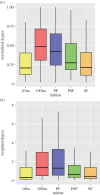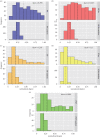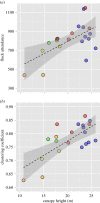Decay of interspecific avian flock networks along a disturbance gradient in Amazonia
- PMID: 24335983
- PMCID: PMC3871315
- DOI: 10.1098/rspb.2013.2599
Decay of interspecific avian flock networks along a disturbance gradient in Amazonia
Abstract
Our understanding of how anthropogenic habitat change shapes species interactions is in its infancy. This is in large part because analytical approaches such as network theory have only recently been applied to characterize complex community dynamics. Network models are a powerful tool for quantifying how ecological interactions are affected by habitat modification because they provide metrics that quantify community structure and function. Here, we examine how large-scale habitat alteration has affected ecological interactions among mixed-species flocking birds in Amazonian rainforest. These flocks provide a model system for investigating how habitat heterogeneity influences non-trophic interactions and the subsequent social structure of forest-dependent mixed-species bird flocks. We analyse 21 flock interaction networks throughout a mosaic of primary forest, fragments of varying sizes and secondary forest (SF) at the Biological Dynamics of Forest Fragments Project in central Amazonian Brazil. Habitat type had a strong effect on network structure at the levels of both species and flock. Frequency of associations among species, as summarized by weighted degree, declined with increasing levels of forest fragmentation and SF. At the flock level, clustering coefficients and overall attendance positively correlated with mean vegetation height, indicating a strong effect of habitat structure on flock cohesion and stability. Prior research has shown that trophic interactions are often resilient to large-scale changes in habitat structure because species are ecologically redundant. By contrast, our results suggest that behavioural interactions and the structure of non-trophic networks are highly sensitive to environmental change. Thus, a more nuanced, system-by-system approach may be needed when thinking about the resiliency of ecological networks.
Keywords: Amazon; forest fragmentation; heterogeneous landscapes; insectivorous birds; mixed-species flocks; network theory.
Figures





Similar articles
-
Flocking propensity by satellites, but not core members of mixed-species flocks, increases when individuals experience energetic deficits in a poor-quality foraging habitat.PLoS One. 2019 Jan 9;14(1):e0209680. doi: 10.1371/journal.pone.0209680. eCollection 2019. PLoS One. 2019. PMID: 30625186 Free PMC article.
-
Seasonal dynamics of flock interaction networks across a human-modified landscape in lowland Amazonian rain forest.Ecol Appl. 2021 Mar;31(2):e02235. doi: 10.1002/eap.2235. Epub 2021 Jan 21. Ecol Appl. 2021. PMID: 33048392
-
Trait-environment relationships differ between mixed-species flocking and nonflocking bird assemblages.Ecology. 2020 Oct;101(10):e03124. doi: 10.1002/ecy.3124. Epub 2020 Jul 23. Ecology. 2020. PMID: 32564355
-
A classification scheme for mixed-species bird flocks.Philos Trans R Soc Lond B Biol Sci. 2023 Jun 5;378(1878):20220100. doi: 10.1098/rstb.2022.0100. Epub 2023 Apr 17. Philos Trans R Soc Lond B Biol Sci. 2023. PMID: 37066650 Free PMC article. Review.
-
Confounding factors in the detection of species responses to habitat fragmentation.Biol Rev Camb Philos Soc. 2006 Feb;81(1):117-42. doi: 10.1017/S1464793105006949. Epub 2005 Dec 1. Biol Rev Camb Philos Soc. 2006. PMID: 16318651 Review.
Cited by
-
Does landscape connectivity shape local and global social network structure in white-tailed deer?PLoS One. 2017 Mar 17;12(3):e0173570. doi: 10.1371/journal.pone.0173570. eCollection 2017. PLoS One. 2017. PMID: 28306748 Free PMC article.
-
Mixed-species bird flocks re-assemble interspecific associations across an elevational gradient.Proc Biol Sci. 2022 Dec 21;289(1989):20221840. doi: 10.1098/rspb.2022.1840. Epub 2022 Dec 21. Proc Biol Sci. 2022. PMID: 36541168 Free PMC article.
-
Social dynamics of core members in mixed-species bird flocks change across a gradient of foraging habitat quality.PLoS One. 2022 Feb 2;17(2):e0262385. doi: 10.1371/journal.pone.0262385. eCollection 2022. PLoS One. 2022. PMID: 35108278 Free PMC article.
-
Flocking propensity by satellites, but not core members of mixed-species flocks, increases when individuals experience energetic deficits in a poor-quality foraging habitat.PLoS One. 2019 Jan 9;14(1):e0209680. doi: 10.1371/journal.pone.0209680. eCollection 2019. PLoS One. 2019. PMID: 30625186 Free PMC article.
-
Environmental disturbance increases social connectivity in a passerine bird.PLoS One. 2017 Aug 30;12(8):e0183144. doi: 10.1371/journal.pone.0183144. eCollection 2017. PLoS One. 2017. PMID: 28854197 Free PMC article.
References
-
- May RM. 2006. Network structure and the biology of populations. Trends Ecol. Evol. 21, 394–399 (doi:10.1016/j.tree.2006.03.013) - DOI - PubMed
-
- Girvan M, Newman MEJ. 2002. Community structure in social and biological networks. Proc. Natl Acad. Sci. USA 99, 7821–7826 (doi:10.1073/pnas.122653799) - DOI - PMC - PubMed
-
- Proulx SR, Promislow DEL, Phillips PC. 2005. Network thinking in ecology and evolution. Trends Ecol. Evol. 20, 345–353 (doi:10.1016/j.tree.2005.04.004) - DOI - PubMed
-
- Bascompte J, Jordano P, Olesen JM. 2006. Asymmetric coevolutionary networks facilitate biodiversity maintenance. Science 312, 431–433 (doi:10.1126/science.1123412) - DOI - PubMed
-
- Guimarães PR, Jordano P, Thompson JN. 2011. Evolution and coevolution in mutualistic networks. Ecol. Lett. 14, 877–885 (doi:10.1111/j.1461-0248.2011.01649.x) - DOI - PubMed
Publication types
MeSH terms
LinkOut - more resources
Full Text Sources
Other Literature Sources

